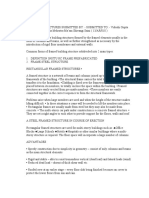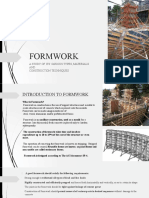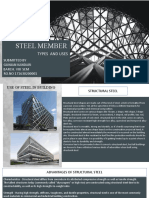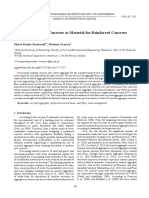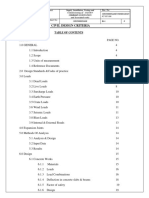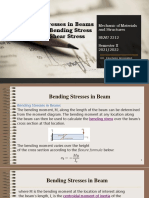0 ratings0% found this document useful (0 votes)
9 viewsBT3 Topic 3 B
BT3 Topic 3 B
Uploaded by
Nicole TaroyBeams are structural elements that resist lateral loads. The document describes 14 different types of beams including universal beams, hip beams, truss beams, lattice beams, composite beams, chilled beams, reinforced concrete beams, steel beams, timber beams, straight beams, curved beams, beam bridges, tie beams, and cantilever beams. It provides details on the purpose, composition, and uses of each beam type.
Copyright:
© All Rights Reserved
Available Formats
Download as PDF, TXT or read online from Scribd
BT3 Topic 3 B
BT3 Topic 3 B
Uploaded by
Nicole Taroy0 ratings0% found this document useful (0 votes)
9 views20 pagesBeams are structural elements that resist lateral loads. The document describes 14 different types of beams including universal beams, hip beams, truss beams, lattice beams, composite beams, chilled beams, reinforced concrete beams, steel beams, timber beams, straight beams, curved beams, beam bridges, tie beams, and cantilever beams. It provides details on the purpose, composition, and uses of each beam type.
Original Title
BT3-TOPIC-3-B
Copyright
© © All Rights Reserved
Available Formats
PDF, TXT or read online from Scribd
Share this document
Did you find this document useful?
Is this content inappropriate?
Beams are structural elements that resist lateral loads. The document describes 14 different types of beams including universal beams, hip beams, truss beams, lattice beams, composite beams, chilled beams, reinforced concrete beams, steel beams, timber beams, straight beams, curved beams, beam bridges, tie beams, and cantilever beams. It provides details on the purpose, composition, and uses of each beam type.
Copyright:
© All Rights Reserved
Available Formats
Download as PDF, TXT or read online from Scribd
Download as pdf or txt
0 ratings0% found this document useful (0 votes)
9 views20 pagesBT3 Topic 3 B
BT3 Topic 3 B
Uploaded by
Nicole TaroyBeams are structural elements that resist lateral loads. The document describes 14 different types of beams including universal beams, hip beams, truss beams, lattice beams, composite beams, chilled beams, reinforced concrete beams, steel beams, timber beams, straight beams, curved beams, beam bridges, tie beams, and cantilever beams. It provides details on the purpose, composition, and uses of each beam type.
Copyright:
© All Rights Reserved
Available Formats
Download as PDF, TXT or read online from Scribd
Download as pdf or txt
You are on page 1of 20
BEAM
structural elements used in
buildings, and they resist
loads applied laterally to
their axis
TYPES OF BEAM
01 UNIVERSAL BEAM 08 STEEL BEAM
02 HIP BEAM 09 TIMBER BEAM
03 TRUSSED BEAM 10 STRAIGHT BEAM
04 LATTICE BEAM 11 CURVED BEAM
05 COMPOSITE BEAM 12 BEAM BRIDGE
06 CHILLED BEAM 13 TIE BEAM
07 REINFORCED CONCRETE BEAM
14 CANTILEVER BEAM
UNIVERSAL BEAM
-commonly refer as an I-beam
-most frequently used beams in steel structures
-horizontal elements of this beam are known as flanges,
whereas the vertical element is the we
-web resists shear forces, and the flanges resist bending
moments
-have a high moment of inertia
-use universal beams when making critical support
trusses or main building frameworks
-ensure a structure has adequate structural integrity
UNIVERSAL BEAM
HIP BEAM
-use a hip beam in the design
of most roofing designs
-support other load-bearing
beams that are separated at
proportioned angles
HIP BEAM
TRUSS BEAM
-stiffened beam by a system
of braces to form a truss and
a bottom chord
-used when there is a lot of
weight to be supported
across vast spaces
-provide reasonable
economical solutions for
buildings with spans over 25
meters
LATTICE BEAM
-girder whereby the web has
diagonal pieces arranged in a
lattice-like manner
-top chord acts in
compression, bottom chord
works in tension
-desirable due to their
lightweight
COMPOSITE BEAM
-made from combining two or
more construction materials
-more robust than beams made
from their constituent parts
-steel and concrete are most
common type
-joining two materials combines
their physical strength and
enhances physical
characteristics
CHILLED BEAM
-heating and cooling systems
that are used for large buildings
-have heat exchangers attached
to ceilings, and they have a
series of pipes
-cost-effective and easy to
maintain
-do not create noise and do not
require a lot of space for
maintenance
REINFORCED CONCRETE BEAM
-composite material made from
concrete and steel bars
-steel bars are added to
increase the relatively low
ductility and tensile strength of
concrete
-most widely used beams in
construction
-advantageous as it can take
high compressive stresses
STEEL BEAM
-made from steel, and they support heavy loads
-specifications depend on their shapes and sizes
-classified depending on their cross-sections into I-beams,
T-beams, channels, and broad flange sections
-can be straight or curved
-can withstand high tensile stresses, therefore providing
increased structural integrity
-resistant to fire and corrosion
-mainly use steel beams in making warehouses, house
frames, and roofing structures
STEEL BEAM
TIMBER BEAM
-horizontal structural supports
made from wood
-standard in wooden frame
structures like residential houses
-can be made either from sawn
lumber or engineered wood products
-faster to erect
-prone to rotting and infestation
-prone to fire
STRAIGHT BEAM
-linear profile on their horizontal
length
-supported on their ends and can
resist bending moments and shear
forces
-relatively easy to construct
STRAIGHT BEAM
CURVED BEAM
-have a curved profile on their
horizontal axes
-supported on their ends and can
resist bending moments, shear
forces, and torsional forces
-common in the construction of
circular buildings and arches
-provide pre-camber for structures
such as bridges
BEAM BRIDGE
-simplest types of bridges to
construct
-consist of bridge spans supported
by piers or abutments on each end
-simplest beam bridge type would be
a wooden log or plank placed across
a stream
-modern beam bridges can be in the
form of plate girders or box girders
TIE BEAM
-horizontal beams that connect
columns, rafters, or trusses
-use tie beams in roofs, cannot carry
heavy vertical loads such as walls
-act as strap beams to remove the
eccentricity of columns in foundation
footings
-prevent highly stressed columns
from buckling outwards
CANTILEVER BEAM
-rigid horizontal beam supported
only on one end
-can be in the form of a typical
beam, slab, or truss
-use these beams in towers, bridges,
and buildings over spans that need
to allow for an overhang
-heavily rely on torque and rotational
equilibrium for stability
You might also like
- Static Analysis of 3D Bridge With AbaqusDocument16 pagesStatic Analysis of 3D Bridge With Abaqusteuku arriessa sukhairi0% (1)
- Resumen MetalDocument12 pagesResumen MetalGuillermo Fernandez PedregalNo ratings yet
- Topics of Questions For Exam Noa019Document2 pagesTopics of Questions For Exam Noa019Guillermo Fernandez PedregalNo ratings yet
- Steel Trusses PDFDocument73 pagesSteel Trusses PDFmayuresh barbarwar100% (1)
- Frame Structures Frame Structures: Hiba A. Al-Kareem Hiba A. Al-KareemDocument27 pagesFrame Structures Frame Structures: Hiba A. Al-Kareem Hiba A. Al-KareemMustafa AhmadNo ratings yet
- FRAMESDocument13 pagesFRAMESNadiakheorobosaNo ratings yet
- Framed Structures 1Document4 pagesFramed Structures 1Festus NgumbiNo ratings yet
- Structural Steel DesignDocument27 pagesStructural Steel DesignLilyNo ratings yet
- Types of StructuresDocument2 pagesTypes of StructuresShubham DuaNo ratings yet
- Types of StructuresDocument3 pagesTypes of StructuresShubham DuaNo ratings yet
- Long Span TrussesDocument25 pagesLong Span TrussesVaishali PardhiNo ratings yet
- Arch 220 - Steel Frame ConstructionDocument9 pagesArch 220 - Steel Frame ConstructionSheikh Mizanur Rahman100% (1)
- Steel in ArchitectureDocument21 pagesSteel in Architectureakarsh100% (1)
- Braced Barrel VaultsDocument26 pagesBraced Barrel VaultsYong Athirah Zamzuri100% (1)
- Structural Engineering OverviewDocument40 pagesStructural Engineering OverviewPatrick Kelly FontanillaNo ratings yet
- Tension Cable RoofDocument19 pagesTension Cable Roofzultrsb689No ratings yet
- Types of Construction Methods - 21122002Document6 pagesTypes of Construction Methods - 21122002shubhankar mishraNo ratings yet
- Framed Structures: Submitted By:-Submitted ToDocument15 pagesFramed Structures: Submitted By:-Submitted ToNidhi MehtaNo ratings yet
- Steel Roof Trusses 2Document35 pagesSteel Roof Trusses 2ASRNo ratings yet
- Pertemuan 12Document59 pagesPertemuan 12Rumah OpungNo ratings yet
- Anqing Yangtze River Railway Bridge, ChinaDocument7 pagesAnqing Yangtze River Railway Bridge, ChinaAngel RondillaNo ratings yet
- Group 3 FormworksDocument82 pagesGroup 3 FormworksZairah Ann BorjaNo ratings yet
- Framing Schematics: Structural Steel ComponentsDocument17 pagesFraming Schematics: Structural Steel ComponentsFrans ChandraNo ratings yet
- Form WorkDocument64 pagesForm WorkAnjali ShahNo ratings yet
- Formwork: A Study of Its Various Types, Materials AND Construction TechniquesDocument39 pagesFormwork: A Study of Its Various Types, Materials AND Construction Techniquessujan pokhrelNo ratings yet
- Formwork: A Study of Its Various Types, Materials ANDDocument26 pagesFormwork: A Study of Its Various Types, Materials ANDCristihan David Riascos NarvaezNo ratings yet
- Formwork 150318073913 Conversion Gate01Document59 pagesFormwork 150318073913 Conversion Gate01mit rami100% (1)
- INtro To SteelDocument29 pagesINtro To SteelAnima PNo ratings yet
- RSW On SteelDocument8 pagesRSW On Steel2240134No ratings yet
- BUILDING CONSTRUCTION Report 1Document11 pagesBUILDING CONSTRUCTION Report 1neetu pahujaNo ratings yet
- Confined Masonry vs. RC Frame With Masonry InfillDocument14 pagesConfined Masonry vs. RC Frame With Masonry InfillChristian Alcedo SantiNo ratings yet
- Formwor K: A Study of Its Various Types, Materials AND Construction TechniquesDocument60 pagesFormwor K: A Study of Its Various Types, Materials AND Construction TechniquesDeep GuptaNo ratings yet
- BLDG TECH Juson Assignment Lecture 3 METALDocument15 pagesBLDG TECH Juson Assignment Lecture 3 METALMa. Janelle GoNo ratings yet
- Steel Member: Types and UsesDocument8 pagesSteel Member: Types and Usesgunjan kandariNo ratings yet
- Steel ConnectionsDocument56 pagesSteel ConnectionsTejas Patel94% (16)
- Metal Roofs: Introduction To Steel RoofsDocument31 pagesMetal Roofs: Introduction To Steel RoofsKalsoom RazaNo ratings yet
- 11 Om Gupta Pre-Cast&FabricationDocument11 pages11 Om Gupta Pre-Cast&FabricationOm GuptaNo ratings yet
- Metals ReviewerDocument4 pagesMetals ReviewermarychilesNo ratings yet
- ASS Unit 2 HalfDocument29 pagesASS Unit 2 HalfSamreen KhanNo ratings yet
- Chapter 5Document41 pagesChapter 5tewele brhaneNo ratings yet
- Steel Is Ideal For Reinforced Concrete Due To Some Unique FactorsDocument2 pagesSteel Is Ideal For Reinforced Concrete Due To Some Unique FactorsLiyakhat aliNo ratings yet
- Steel Properties and UsageDocument24 pagesSteel Properties and UsageizatyNo ratings yet
- Frame Structures 2Document39 pagesFrame Structures 2Hamza Siddiqi100% (1)
- ConstructionDocument2 pagesConstructionJohn MatzNo ratings yet
- Framing System (Written Report)Document14 pagesFraming System (Written Report)Wincy Sta AnaNo ratings yet
- Unit 4Document17 pagesUnit 4sandeepNo ratings yet
- Portal Frame Structure: Lect 8Document35 pagesPortal Frame Structure: Lect 8jkaliwonNo ratings yet
- Chapter One - Introduction To Steel StructuresDocument8 pagesChapter One - Introduction To Steel StructuresJohn Philip Molina NuñezNo ratings yet
- Advanced Reinforced Concrete Construction SystemsDocument39 pagesAdvanced Reinforced Concrete Construction SystemsjeanmauricevillarinbacolodNo ratings yet
- Framed StructuresDocument12 pagesFramed Structures211Dena hassan mohamedNo ratings yet
- Structure in Architecture 1Document48 pagesStructure in Architecture 1Nayaab100% (1)
- Trusses (Railway Bridges)Document30 pagesTrusses (Railway Bridges)Gargi KoulNo ratings yet
- Stuctures PortfolioDocument77 pagesStuctures PortfolioIndraja RmNo ratings yet
- CH01 Superstructure (Type of Building Structure) - Week 2Document57 pagesCH01 Superstructure (Type of Building Structure) - Week 2Umi NadiaNo ratings yet
- Btech 1 M1Document12 pagesBtech 1 M1corbitecoNo ratings yet
- Structural ElementsDocument24 pagesStructural ElementsDivya chowdary100% (1)
- Types of Steel Used For ConstructionDocument11 pagesTypes of Steel Used For ConstructionVilasini KumaranNo ratings yet
- A Guide to Some of the Equations used in Constructing a Suspension BridgeFrom EverandA Guide to Some of the Equations used in Constructing a Suspension BridgeNo ratings yet
- A Short Guide to the Types and Details of Constructing a Suspension Bridge - Including Various Arrangements of Suspension Spans, Methods of Vertical Stiffening and Wire Cables Versus Eyebar ChainsFrom EverandA Short Guide to the Types and Details of Constructing a Suspension Bridge - Including Various Arrangements of Suspension Spans, Methods of Vertical Stiffening and Wire Cables Versus Eyebar ChainsNo ratings yet
- (Eng) Advanced Concept Training Steel 2011.0 - Nemetschek SciaDocument123 pages(Eng) Advanced Concept Training Steel 2011.0 - Nemetschek SciaYuri ScripnicNo ratings yet
- Analysis of Shear Forces and Flaxural Moment at Joints in PCI-Girder Precast Concrete Segmental BridgeDocument7 pagesAnalysis of Shear Forces and Flaxural Moment at Joints in PCI-Girder Precast Concrete Segmental BridgeInternational Journal of Innovative Science and Research TechnologyNo ratings yet
- Mech EngineeringDocument48 pagesMech EngineeringkotavNo ratings yet
- 7135-Article Text-23618-1-10-20140623Document7 pages7135-Article Text-23618-1-10-20140623Jibran KhanNo ratings yet
- Deformation Due To PrestressingDocument6 pagesDeformation Due To PrestressingBodhi RudraNo ratings yet
- SolatDocument7 pagesSolatRohitNo ratings yet
- Structural 3 Q PDocument14 pagesStructural 3 Q PKusum KalitaNo ratings yet
- Beam & ColumnDocument5 pagesBeam & ColumnAnonymous nwByj9LNo ratings yet
- Internship ReportDocument71 pagesInternship ReportDepartment of Civil EngineeringNo ratings yet
- ETABSDocument6 pagesETABSAbuturab SharikmaslatNo ratings yet
- Thesis PresentationDocument28 pagesThesis PresentationAfham AhmadNo ratings yet
- Eurocode Basic - Concepts PDFDocument27 pagesEurocode Basic - Concepts PDFgranadosvargasNo ratings yet
- Guidelines For Lab Report WritingDocument4 pagesGuidelines For Lab Report Writingkostas.sierros9374100% (1)
- 88 114Document31 pages88 114William Henderson100% (2)
- LEX - Project Terms and Definitions of Wind TurbineDocument49 pagesLEX - Project Terms and Definitions of Wind TurbineG.RameshNo ratings yet
- Lecture 4 Flexural MembersDocument27 pagesLecture 4 Flexural MembersEdwin RodriguezNo ratings yet
- Floating ColoumnDocument19 pagesFloating Coloumnsahil mujawarNo ratings yet
- Distributing The Load of Bridges Over The GirdersDocument28 pagesDistributing The Load of Bridges Over The GirdersovikbasuNo ratings yet
- Mece Lab 1 Shear ForceDocument5 pagesMece Lab 1 Shear ForceTLHOKOMELO MOLOINo ratings yet
- Seismic Design PDFDocument12 pagesSeismic Design PDFhardianto gaulNo ratings yet
- Strut & Tie Method (The Concrete Center)Document60 pagesStrut & Tie Method (The Concrete Center)Θανάσης ΓεωργακόπουλοςNo ratings yet
- Lecture Notes Lectures 1 4Document29 pagesLecture Notes Lectures 1 4Penelope MalilweNo ratings yet
- sOM NotesDocument48 pagessOM NotesmaniNo ratings yet
- Design BasisDocument33 pagesDesign BasisSivaAgathamudi100% (1)
- Bridge Deck With Link-SlabDocument31 pagesBridge Deck With Link-Slabquithanqui100% (1)
- Stresses in Beam With ExamplesDocument13 pagesStresses in Beam With ExamplesAnisyahira khalidNo ratings yet
- Last DayDocument58 pagesLast DayAnshu RajNo ratings yet
- Plate 45 ES205Document1 pagePlate 45 ES205Kirstin AwitenNo ratings yet
- Machine DesignDocument16 pagesMachine DesignArhon BarcelonNo ratings yet







